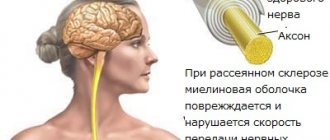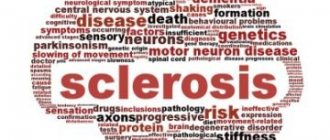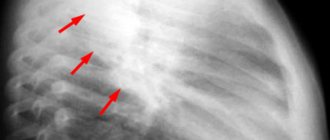The relationship between multiple sclerosis and heredity is of interest to everyone, but especially to women of childbearing age when planning a family. This is especially true since young women get sick 2-3 times more often than men. It is most important for them to know for sure whether multiple sclerosis is inherited. The issue is being actively studied, and we can only talk about a certain predisposition that exists not only for multiple sclerosis, but also for any other chronic disease.
Causes
There are general and direct causes that contribute to the occurrence of multiple sclerosis:
- The European race is at risk.
- There is a chance of getting sick if one of your blood relatives in the family has already had this disease.
- The disorder most affects women.
- Moving to another natural area, sudden climate change.
Provoking environmental factors:
- Viral and bacterial diseases in chronic form (for example, herpes).
- Great physical and emotional stress.
- Hereditary predisposition.
- Lifestyle, nutrition.
- Female birth control pills may be one reason.
- Deficiency of vitamins and other microelements.
- At risk are people who have received a dose of radiation and chemical poisoning.
Prevention
Prevention of sclerosis is aimed at slowing the progression of pathological processes:
- Normalization of psycho-emotional state.
- Performing prescribed physical activity.
- Prevention of infectious diseases.
- Women are advised to protect themselves from pregnancy, as it can provoke an exacerbation of sclerosis.
By carrying out preventive measures, you can achieve stable remission.
Is there a genetic predisposition to multiple sclerosis?
If your family already has or has had multiple sclerosis, your risk of getting the disease increases. This does not mean that the disease will definitely come. Other reasons, along with heredity, can also serve as the impetus for the onset of the disease.
Long-term research shows that the disease is not transmitted through a gene; a person inherits the risk of developing such a disorder, and not the disease itself. These same studies have shown that some of our genes contribute to the synthesis of myelin in the body, which is the impetus for disease.
The human body is constantly exposed to various bacteria and microbes, to which it reacts differently. This natural reaction is genetically determined. Therefore, it cannot be ruled out that the same disease in close relatives will have the same course.
Statistics on possible transmission of the disease to children
Since the discovery of this disease, many studies have been conducted on the transmission of this disease to children. However, the most complete picture was presented by a group of Swedish scientists, consisting of doctors and analysts.
The studies included data from all national disease registries and involved more than 28,000 people. As a result, it was revealed that the probability of transmitting MS by inheritance was less than one percent (initially it was believed that it was 3%).
Additional research has also been conducted to determine whether the gender of the parent affects the transmission of genes (initially it is believed that genetic diseases are transmitted mainly through the maternal line) and whether the likelihood of MS in twins increases.
The data from these studies showed surprising numbers. The risk of transmitting the disease from father to child was slightly higher (by several percent) than from mother.
What is the risk of multiple sclerosis in relatives?
Statistics show that multiple sclerosis affects 30 times more people from families with a history of the disease. The risk is greater if a very close relative is sick: parents, sisters and brothers. The disease may not affect you if the sick person is only a distant relative.
In the risk group, blood brothers and sisters, from 2% to 5%, parents may not get sick. If one of the parents is sick, the child has a risk of getting multiple sclerosis; the percentage risk reaches 2%.
In twins, if they are identical, the risk of getting sick reaches 35%, and if they are fraternal, then only up to 5%. Fraternal twins usually have different genotypes. If we take all cases of multiple sclerosis, the following picture emerges: 10% of all patients have close relatives who have already encountered this disorder.
Females are more vulnerable to this disease than males . It was previously noted that women between 20 and 40 years of age are most susceptible to multiple sclerosis. Today there are already other statistics according to which the disease affects people from the age of 15. Up to the age of 50, females are more vulnerable to this disease than males.
Distribution of morbidity depending on climatic conditions
It is believed that multiple sclerosis progresses in countries with temperate climates, where people do not get enough vitamin D. Out of 100 thousand people, in northern countries, where daylight hours are short, from 50 to 100 people become ill. This also includes food preferences; fatty meat is consumed more in regions with a harsh climate.
Climate cannot be considered a 100% risk factor, because you can always change your place of residence. Only at the age of 18 does the formation of the human immune system complete; doctors advise moving and raising children in a comfortable climate if there is a predisposition to the disease.
Treatment methods
Treatment of the pathology is individual and directly depends on the stage. The therapy is complex in nature, which is why doctors from different specialties take part in it: neurologist, neuropsychologist, ophthalmologist, urologist, immunologist and other specialists.
The prescribed treatment should include the following drugs:
- Drugs that have a suppressive effect on the development of the disease. Most often, hormonal immunosuppressants are selected.
- Vitamins.
- Drugs that improve metabolic processes.
- Antihistamines.
- Means for strengthening blood vessels.
At the same time, symptomatic therapy is included, aimed at correcting the main clinical manifestations of sclerosis.
How does the state of the environment affect?
Environmental problems exist everywhere today, but they are not always so critical as to be the impetus for the occurrence of multiple sclerosis. It’s another matter if a person has been exposed to radiation for a long time. Chemical poisoning can also be one of the reasons . In regions where there are problems with clean water for drinking, the environmental situation is also considered a risk zone.
Whatever the ecology in the place where you live, it will not be ideal in our century. In order not to further aggravate unfavorable factors, you need to take care of your health . Alcohol and nicotine are also poisons that people voluntarily poison themselves with. Giving up bad habits, playing sports, proper and healthy eating, vitamins and minerals in sufficient quantities are suitable prevention of multiple sclerosis.
Mental problems
Today's medicine claims that there is no relationship between the stable influence of stressful situations on the body and multiple sclerosis. Experts agree that mental problems, which are usually classified as sclerosis, are caused by negative factors.
Mental disorders and negative emotions do not provide anything positive to the body, and therefore the negative impact on the central nervous system must be minimized.
Diagnosis of multiple sclerosis
Multiple sclerosis is diagnosed due to the following factors:
- The disease began between the ages of twenty and fifty.
- The presence of signs that indicate disturbances in the functioning of the spinal cord or brain.
- MRI shows symptoms of two or more points of demyelination.
- Two or more moments of deterioration lasting at least 24 hours with a break of thirty days.
- There is no other option for deciphering the signs of the disease.
Specialists in the field of neurological research at Yusupov Hospital use methods for detecting multiple sclerosis:
- Evoked potentials (EMG EP) . This method is based on the fact that in multiple sclerosis, due to the splitting of myelin, a blocker of nerve conductors, the reaction of impulses becomes slower. The speed of action is recorded by equipment, then the data is processed on a computer.
Based on the available information, specialists determine the rate of decrease in the activity of nerve impulses, this is considered presumptive confirmation of the presence of demyelinating pathology.
- MRI makes it possible to clearly see areas of demyelination.
- Study of cerebrospinal fluid , which is obtained through puncture. Positive test results are detected in ninety percent of patients with multiple sclerosis.
- A comprehensive study of the blood composition makes it possible, through certain chemical compounds, to identify the presence of special enzymes in the blood; they are present in patients with multiple sclerosis.
- An eye examination allows an ophthalmologist to see typical changes in the fundus and identify signs of abnormalities.
The combined use by doctors of the Yusupov Hospital, procedures in medical institutions, x-rays, tests and the use of electrical devices makes it possible to identify multiple sclerosis at the onset of the disease, determine the severity of the situation, the degree and state of the disease.
Timely detection of multiple sclerosis means a lot for health; timely treatment should delay the deterioration of the patient’s health.
Symptoms
The main and most common symptom of the disease is visual impairment. As a rule, this happens unexpectedly, most often after waking up. A person may notice a blurry picture, a veil before the eyes, spots, etc. With these complaints, the patient goes to an ophthalmologist and, as a rule, the diagnosis in this case is an infectious lesion of the optic nerve, i.e. retrobulbar neuritis. In most cases, people with this diagnosis become potential patients with multiple sclerosis.
A common symptom is gait disturbances and motor skills disorders. Next, speech is disrupted, which becomes incoherent and slurred, and urination becomes more frequent. The person may begin to feel sick or vomit. Common symptoms include: tremors of the limbs, lack of strength, decreased concentration and ability to work, breathing problems, rapid pulse; men may experience problems in the sexual sphere, impotence.
The main and most common symptom of the disease is visual impairment. As a rule, this happens unexpectedly, most often after waking up. A person may notice a blurry picture, a veil before the eyes, spots, etc. With these complaints, the patient goes to an ophthalmologist and, as a rule, the diagnosis in this case is an infectious lesion of the optic nerve, i.e.
retrobulbar neuritis. In most cases, people with this diagnosis become potential patients with multiple sclerosis. A common symptom is a disturbance in gait and motor skills. Next, speech is disrupted, which becomes incoherent and slurred, and urination becomes more frequent.
Symptoms are varied and individual for each patient. This makes it difficult to make a diagnosis and determine the degree of disability.
For the most accurate diagnosis today, the EDSS (Expanded Disability Status Scale) scale is used - an expanded scale for determining the level of disability. The peculiarity of EDSS is that it evaluates the state of seven functional systems of the body simultaneously.
- Visual – visual acuity is assessed.
- Pyramid – assesses the tone and strength of the muscles of the limbs.
- Stem – the work of the brain stem, which is responsible for receptors, eye muscles, swallowing and salivation functions, and chewing muscles, is assessed.
- Cerebellar – assesses coordination, sense of balance and the patient’s sense of the body in space.
- Sensitive - the patient’s ability to feel touch, temperature, tingling and other external influences is analyzed.
- Pelvic – the functioning of the pelvic organs, bladder and bowel function is assessed.
- Cerebral – the patient’s cognitive abilities and changes in the emotional background are analyzed.
Help: when assessing each of the seven systems, a certain number of points is assigned - the more severe the symptoms, the more points. The results are then interpreted and a total score is given.
The interpretation is as follows:
0 points – no abnormalities were identified, the patient is completely healthy.- 1 point – deviations in one of the systems that are not apparent externally.
- 2 points – minimal disability, not causing serious discomfort to the patient.
- 3 points – moderate disability in one or minimal in three or four systems; therapy at home is possible.
- 4 points – increasing disability while maintaining an active lifestyle; the need for outpatient treatment. The main criterion is the patient’s ability to walk 500 meters independently.
- 5 points – outpatient treatment; independent walking 200 meters.
- 6 points – walking 100 meters or less with the help of a cane.
- 7 points – walking is almost impossible even with the use of assistive devices; need to use a wheelchair.
- 8 points – lack of movement while maintaining the ability to care for oneself.
- 9 points – loss of self-care skills, constant stay in bed.
- 10 points – death.
We invite you to read Tips for buying a new car
The main diagnostic methods include studying the patient's complaints and taking an anamnesis. To clarify the diagnosis and identify the localization of sclerotic plaques, magnetic resonance imaging (MRI) using a contrast agent is used. As an additional diagnostic method, analysis of cerebrospinal fluid for the level of leukocytes and lymphocytes is used.
Treatment and prevention
Curing multiple sclerosis aims to eliminate relapses and reduce the activity of anti-immune activity. For relapses, artificial glucocorticosteroids and methylprednisolone are used. During remissions, medications such as interferon beta, glatiramer acetate and teriflunamide are used to prevent recurrent attacks.
These medications are classified as a group of drugs that modify the disease process. They are known for their immunorestorative effect, reducing the activity of T-lymphocytes and slowing down their proliferation. They reduce the speed of immune system cells flowing through the protective barrier, preventing damage to the white matter of the brain.
Today's treatment methods are not able to affect the reversibility of the disease; they can stop its formation and stabilize the patient's condition. There are no specific ways to prevent multiple sclerosis, since the specific cause of the disease has not been identified.
To reduce the possibility of its occurrence, it is advised to monitor the preconditions , if possible, beware of serious stressful situations, stop smoking and do not ignore preventive procedures.
Multiple sclerosis is a disease with a specific path of onset that has not yet been fully studied. But every year the study of this disease brings new results, and one can count on the development of effective methods and methods for preventing the disease in the near future.
Gene factor for disease development
MS itself is not a hereditary disease, however, due to many years of research, a clear relationship was found that relatives are actually much more likely to develop this disease than those who did not have it in their family.
It has not yet been possible to identify a specific gene that affects the occurrence of MS, but some differences are visible in the combination of mutation frequencies of HLA class I and class II genes depending on the nationality and race of patients.
For example, in the USA, an increased connection between the appearance of multiple sclerosis and the presence of antigens B7, DR2 in patients was noticed, in Central Russia - with the A3 and B7 loci, in Siberia - A1, A9, B7.
In peoples living in Europe with this disease, the haplotype DR2 (DW2) DRB1*1501 - DQA1*0102 - DQB1*0602 of the HLA class II system is most often determined.
Factors that can lead to mutations in genes include:
- A mutation in T-lymphocytes, when some of them cease to perform a protective function and begin to destroy the immune system.
- Bad habits - alcohol, smoking, drugs.
- Frequent viral, infectious and fungal diseases.
- Constant stress.
Genetic MS can occur in the following scenarios:
- Relapsing-remitting multiple sclerosis. It is characterized by rare periods of exacerbations, with the possibility of full recovery with proper treatment.
- Secondary progressive sclerosis. With this form, the symptoms worsen constantly, but with fairly long periods of remission.
- Primary progressive sclerosis. Rare periods of remission. The patient's condition is permanently deteriorating.
- Sclerosis that progresses with exacerbations is a constant deterioration of the condition, there are practically no periods of remission.
Genetic predisposition as a cause of the development of multiple sclerosis:












